I’m between projects right now, so I’m goofing off by blogging about a course I’m taking from the University of Arizona, “Postmodern Art and its Discontents,” by professor Paul Ivey.
From the Syllabus:
October 6, 2014
 The first lecture was “What is Postmodernism?” In three hours and a dizzying blur of slides, Ivey made the case that the postmodern world view rejects the essentialism of modernity that comes out of The Enlightenment. It rejects universal themes and focuses instead on relativism and particularities: surfaces, colors and forms for their own sake.
The first lecture was “What is Postmodernism?” In three hours and a dizzying blur of slides, Ivey made the case that the postmodern world view rejects the essentialism of modernity that comes out of The Enlightenment. It rejects universal themes and focuses instead on relativism and particularities: surfaces, colors and forms for their own sake.
However, after the class, I had a nagging doubt. In every example shown in class, the artist had believed he (all males) was projecting some essential meaning. Mondrian had his spiritual thing with horizontals and verticals. Rothko believed he was expressing emotion so purely that viewers of his work would experience exactly what he experienced. Pollack was expressing himself in universally appreciated kinetic action, Kandinsky was painting “inner necessity,” and so on. (A lot of the slides were from the abstract expressionists, but not all). These were all “theories” or at least world views, that presuppose universals and essentials – basically modernist views.
So I began to suspect that while viewers of art, academics, and especially critics, like Clement Greenberg, could take the postmodern view, an artist could not. If you’re an artist, you have to believe in something. You have to believe that what you’re doing has some intrinsic, if not universal meaning, otherwise you wouldn’t do it. You have to believe in essences and universals, because if you didn’t, there would be no difference between serious painting and a 5-year old wallowing in fingerpaints.
So I formed the hypothesis that there really are no postmodern artists, only postmodern critics and consumers of artistic product. This would be consistent with some critical theory, such as Art Danto’s in “The Madonna of the Future.”
So before the second class, I offered my new hypothesis to Professor Ivey and asked him what he thought. He gave a plausible, but not entirely satisfying reply. He said that the distinction between modern and postmodern world views should not be taken as antipodes. Some (many) artists concern themselves mainly with surface and colors rather than meaning, but that does not mean they have empty heads. When they create art, they still have something in mind, perhaps some essential thing or intrinsic property, but their sensibility runs to relativism or decoration or self-reference, or some other postmodern value. It’s not a black-and-white either-or situation between modernism and postmodernism.
Well, okay. But that does not refute my hypothesis, which, in my opinion, still stands. You heard it here first.
October 13, 2014
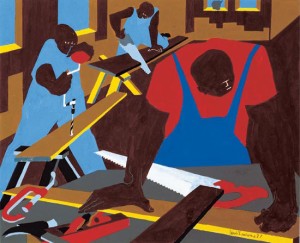 The second lecture focused, first, on postmodernism in architecture, because, according to the prof., it was in architecture where postmodernism first took root. The so-called international style, after WWII, was supposed to be rational, functional, and not ethnic – thus international. You could build the same glass and steel box in New York or Bombay. Supposedly, it was “honest” architecture, not pretending to be a Greek temple or anything other than what it was. In that sense, it was post-modern, because it rejected the Enlightenment ideal of individual self-expression.
The second lecture focused, first, on postmodernism in architecture, because, according to the prof., it was in architecture where postmodernism first took root. The so-called international style, after WWII, was supposed to be rational, functional, and not ethnic – thus international. You could build the same glass and steel box in New York or Bombay. Supposedly, it was “honest” architecture, not pretending to be a Greek temple or anything other than what it was. In that sense, it was post-modern, because it rejected the Enlightenment ideal of individual self-expression.
Las Vegas, NV, was held out as another example of postmodern architecture, where many of the buildings are simulacra. They start out as parodies, or imitations of other structures, like the Eiffel tower. However, after time, they become themselves a kind of alternate reality : “The Eiffel Tower-the one in Las Vegas.” Disneyland is another example. Mickey Mouse is a real entity, though not a real mouse. He is hyper-real.
The point is that the visitor should have feelings around the signifiers, not the truth of what it is (which is essentially, nothing). That’s exactly why I despise Las Vegas. I see it as purposely superficial and cynically manipulative. But the professor loves the architecture there. Exact replicas are real, he says. There is no deep essentialism of the thing. It is what it is. I guess I am a modernist at heart.
The second half was a history lesson – America in the 1950’s. What were the images and values expressed at that time, and how did they set the context for subsequent art in America, and possibly, the roots of postmodernism? We looked at works by Jasper Johns, Norman Rockwell, Robert Frank, and Eduardo Paolozzi, among many others.
Again after the class, I had a thought. (This professor is like a fire hose – he puts out ideas way faster than I can process, so when he asks at the end, “Are there any questions?” I don’t have any. I have them on the drive home.)
My question was something like this: Of all the work we saw, from the 1950’s and some 1960’s, it represented modernism in mainstream culture, mostly. We saw a lot of advertisements from the period. Mid-century interior design, which reflected the way of life of the middle classes, tended to minimalism, clean lines, and functionalism, so, a hint of postmodernism there. (My house is today decorated in that style – I love it.)
BUT, every single example we saw showed white, middle-class people, most of them prosperous, or aspirationally so. Donna Reed. Ozzie and Harriet. Leave it to Beaver. Where were the images of waiters, shop clerks, hotel maids, drug addicts, priests, military men, shoe shiners, blacks, Puerto Ricans, Chinese? Where were those images? Where the hell was Jacob Lawrence? I felt I had been hoodwinked into a false cultural history.
Then, on reflection, I thought maybe the language of the visual arts simply is a white, middle-class, developed-world, rich-people’s language. Other groups – the poor, minorities, the uneducated, immigrants, the sick, the stupid, the marginalized – they simply do not speak the language (or didn’t – early to mid-20th century –things are different now, though not by much, I would say). Like, if you want to play polo, you’re going to need a horse. It’s not discriminatory – it’s just a requirement for getting into the club. Visual arts might have been like that. May still be.
In order to partake of the visual arts, since mid 19th century, I would say, you needed the leisure time to do so, the disposable income, the education, and the cultural experience that allows those works to speak to you – experience like mainstream television, politics, jobs, and so on. This my hypothesis for why the history of the visual arts that the professor gave was so biased. Jacob Lawrence was an outlier.
If this is a correct hypothesis, then I understand better, but I’m still not happy. The prof. should have framed his lecture in a way that would allow us to understand his presentation as a certain point of view and not as “the” social history of mid-century. I have questions!
October 20, 2014
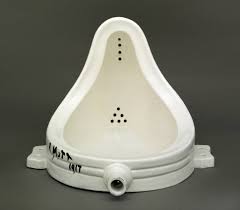 The third lecture opened with the professor setting up Marcel Duchamp as a pivot point in the history of art. Around 1917, Duchamp declared that art is a conversation, and that meaning is not in the art object. This is why he was able to mount a urinal on a wall in a museum and declare it as art. The viewer brings interpretation to the object and the artistic meaning is found in the conversation with the artist (and among viewers and critics). This idea was the birth of postmodernism in art, according to the professor.
The third lecture opened with the professor setting up Marcel Duchamp as a pivot point in the history of art. Around 1917, Duchamp declared that art is a conversation, and that meaning is not in the art object. This is why he was able to mount a urinal on a wall in a museum and declare it as art. The viewer brings interpretation to the object and the artistic meaning is found in the conversation with the artist (and among viewers and critics). This idea was the birth of postmodernism in art, according to the professor.
The so-called pop artists embraced the idea that the object itself has no meaning – only the artistic dialog does. In dance, for example, Merce Cunningham worked with “found movements,” much as Duchamp used found objects. Cunningham’s dances contained no narration or emotional expression, he said. They meant nothing in themselves. They were just movements.
Robert Rauschenberg, who made sets for Cunningham performances, embraced the idea. He assembled found objects and called them art. He denied that they expressed anything. The point of art is not for the artist to express feelings – who cares about that? The point is to have a dialog about what artistic objects might mean.
Rauschenberg wanted to achieve total objectivity in art, presenting objects and images that had no personal significance to him and did not express anything about himself. This is the opposite of abstract impressionists like Pollock. Rauschenberg also claimed that identical pictures are each valid works of art. The concept of “the original” derives from abstract expressionism (ab-ex, in the professor’s argot). The work is the trace of the “original expression.” But if nothing is being expressed, then “original” is not defined. Two identical works of art are both works of art of equal value.
It’s a short step from there to Andy Warhol, who delighted in making multiple silk-screen images of the same content, and declaring that each was an original work of art (and pricing each one accordingly). Thus we get the famous repetitive images of Campbell’s soup cans, Marilyns, and Elvises.
At this point, I had an actual question in the middle of the class. Were these pomo artists mistaken about what they were doing? From philosophy and literature of the time (and later), many scholars argued that there is no such thing as objectivity. That is a myth of science. Everything is interpreted, because we are human.
Every “found” object is found and selected by someone, for some purpose, because it means something to them. Likewise, assembling collage-like works that include objects and news clippings, refrigerator doors, car bumpers, and other seemingly random objects, is not an objective activity. The result is framed, and it is often graceful, beautiful and even expressive (Rauschenberg’s “Rebus” is an example).
I grant that the artist may have no articulate thesis in mind, no premeditated purpose for collecting and assembling certain objects, but that only means the meaning, the self-expression, is more subconscious than conscious, but it’s still there. It is not possible to escape your humanity. Warhol claimed he was a machine and his studio was a factory, and he swore there was nothing of himself in the works he produced, but I don’t believe that for a minute. Just look at his very powerful images for proof. Machines lack creativity. They lack the motivation of the artistic impulse. They lack aesthetic sensibility. They lack values and judgment. They lack the desire to communicate with people by producing art. Andy Warhol was no machine.
So my hypothesis is that the post-Duchampian pop artists were either deluded or disingenuous about the rationale for their work, because it is not humanly possible to not be a human. I was totally ready at the end of the class when the professor finally asked if there were any questions. It was my big chance! Alas, I was unable to articulate my thoughts as well as I have here and I only managed to blurt out the objection that there is no objectivity, so what was up with these guys?
The professor’s generous answer was that yes, these pop art works necessarily express subjectivity but not in the same sense as the ab-ex artists, who were all about individual subjectivity, the “trace of the trembling hand,” he called it. The pop artists were subjective in the sense of being tuned into the collective – consumerism, advertising, economics, mass production, popular life – but not in the sense of having individual feelings to express. I thought that was a pretty good answer, although a bit revisionist, a bit art-historian; not consistent with the pronouncements of the artists themselves. Of course artistic manifestos are usually vainglorious, and probably shouldn’t be taken at face value.
The lecture also considered Jasper Johns and his “collection” of found symbols, which are not exactly the same as found objects, in some way that is hard to specify. A painting of an American flag – is it art? It’s not a flag. It’s not “just” an object made of encaustic and newsprint, but it is something.
The same with Johns’ famous target pictures. Targets have meaning, but he didn’t mean anything by painting them, he said. Again, I don’t believe that. Targets have social meaning. A target is something that receives violence, or at least harm, from an arrow, a gun, or a criticism. You can be a target of an investigation. A target never sings, for example. It has a specific social meaning and that’s why it is a symbol. So to present targets by saying “Oh, these images don’t mean anything; they’re just paint on canvas,” is to miss the target. My view is that Johns and the others were still doing abstract expressionism, but with minimal explicit intentionality.
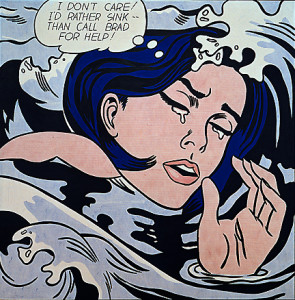 There was a section on Lichtenstein and his cartoony comic-book-like works, which are sort of iconic of the pop art movement. Lichtenstein said he was picturing detachment. The cartoon format made the content of every picture ironic, even (especially) when the content was about war, violence, sex, romance, and so on. That description seems suspicously expressive to me.
There was a section on Lichtenstein and his cartoony comic-book-like works, which are sort of iconic of the pop art movement. Lichtenstein said he was picturing detachment. The cartoon format made the content of every picture ironic, even (especially) when the content was about war, violence, sex, romance, and so on. That description seems suspicously expressive to me.
Another question bubbled up: What is the relation between a caricature and a photograph? Caricatures are ironic, because they are minimalist and they exaggerate certain key features and minimize others (but what are “key features” – that’s an embedded question). Photographs are literal representations. Lichtenstein was a caricaturist, in some way. But what is a caricature? I wasn’t sure the question was germane enough, or that I could articulate it concisely, and time was up, so I had to let it go, and maybe that was just as well, because my brain was exhausted.
October 27, 2014
After pop art blew its cortex, the next, reactionary, movement was Minimalism, which pushed even further the idea that art need not be either representational or expressive. Rather, the minimalists said, art objects existed in-themselves without referring to anything. Pop artists like Warhol and Lichtenstein were referring to popular culture; their works were still signifiers. Minimalists eschewed signification and insisted that their stark cubes, levers, and monochrome canvases referred to nothing at all. They defied you to “read” a minimalist piece as a picture of anything. Their sculptures were not sculptures, but “presences” that did not occupy or define any representational space.
If all that sounds like overcaffeinated academic theory, it probably was. Minimalist art was/is harsh. “Not loveable,” in the words of the professor. The art objects of the minimalists were designed to exist without emotion or intellect, without symbol, message or color. They constituted art only because they occurred in art galleries, in the tradition of Duchamps’ famous urinal. We looked at Carl Andre’s arrangement of 157 fire bricks in a line on the floor, called “Lever.” Such works would make anyone want to yell out, “You call that art?”
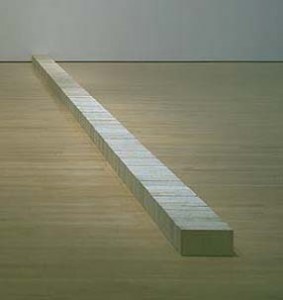 Despite the austere, almost cynical, poke-you-in-the-eye nature of these minimalists works, I thought they had at least one redeeming virtue. The professor asserted that these works reveal the space of the gallery they are shown in, and that, in turn, refers to the body of the viewer. For example, with Andre’s bricks on the floor, you have to decide if you are going to walk around them, step over them, or even step on them. The “meaning” of the artwork is actually to make the viewer aware of his or her embodiment with respect to the work. I think that’s about right.
Despite the austere, almost cynical, poke-you-in-the-eye nature of these minimalists works, I thought they had at least one redeeming virtue. The professor asserted that these works reveal the space of the gallery they are shown in, and that, in turn, refers to the body of the viewer. For example, with Andre’s bricks on the floor, you have to decide if you are going to walk around them, step over them, or even step on them. The “meaning” of the artwork is actually to make the viewer aware of his or her embodiment with respect to the work. I think that’s about right.
The idea could have been explained more elegantly as “anomalous affordances,” referring to James Gibson’s 1979 “theory of affordances” in his last book, The Ecological Approach to Visual Perception. That theory, based on the work of Gestalt psychologist Kurt Koffka, recognizes that things in the world, the whole environment in fact, present “opportunities for behavior” called affordances, to whatever animal perceives them. A pond affords locomotion for a duck but not for a cat. An empty space is a stage (for a human of certain disposition). As Koffka said, “Banana says ‘Eat me,’ water says ‘Drink me,’ woman says, ‘Love me.’” (That was in the 1930’s).
Gibson’s theory of affordances is a lot more sophisticated than that, but that’s the idea. Minimalist works of art present the viewer with affordances for behavior, but not the ones you expect. When you find 157 bricks laid out on the floor of an art gallery, you’re not sure what the affordances are, and you have to consider. It offers an anomalous affordance, and that’s the name of the game for minimalist art. That’s my interpretation and I’m sticking to it.
Inevitably, there was a theoretical reaction against the minimalists. The so-called post-minimalists (yes!) objected that minimalist art was disconnected from its zeitgeist. These were the sixties, after all, a period of great social and moral upheaval, yet the minimalists failed to reflect anything about the world that contained it. It’s not a very cogent criticism, it seems to me, since that was exactly the goal the minimalists sought: to create art that did not refer to anything.
Nevertheless, the post-minimalsts moved away from objects of any kind and looked only at materials. If you’re going to purposely make meaningless art, they seemed to say, why bother even to lay bricks on the floor. Just take the bricks and pile them in a heap. It’s not about the line on the floor; it’s about the bricks.
 So, for example, we have Robert Morris’ piece, “Pink Felt,” which amounts to nothing more than a pile of pink felt strips thrown in a corner. It’s not even a recognizable object. Forget objects. The artistic interest should be in materials. How is that germane to the times? The post-minimalists were even more obscure than the minimalists, but they claimed social relevance because society is built out of materials, and processes are applied to them, like cutting, throwing, piling, stretching, and so on. I think that rationale is pretty lame, but like the minimalists, the real post-minimalist artistic virtue is in presenting anomalous affordances. When you confront a pile of pink felt, your first reaction is that it’s trash – it affords nothing more than disposal. But then you start thinking that it looks soft, flexible, smooth-ish, lightweight but warm, not pink anymore – not a pleasant color, but if I was a rat, it would afford great nesting, and before you know it, you’re off on a mental journey involving consideration of all the object’s affordances. So I do think even the most nonsensical post-minimalist work has artistic virtue. Perhaps not really worth the effort to extract it, however. But it had to be done.
So, for example, we have Robert Morris’ piece, “Pink Felt,” which amounts to nothing more than a pile of pink felt strips thrown in a corner. It’s not even a recognizable object. Forget objects. The artistic interest should be in materials. How is that germane to the times? The post-minimalists were even more obscure than the minimalists, but they claimed social relevance because society is built out of materials, and processes are applied to them, like cutting, throwing, piling, stretching, and so on. I think that rationale is pretty lame, but like the minimalists, the real post-minimalist artistic virtue is in presenting anomalous affordances. When you confront a pile of pink felt, your first reaction is that it’s trash – it affords nothing more than disposal. But then you start thinking that it looks soft, flexible, smooth-ish, lightweight but warm, not pink anymore – not a pleasant color, but if I was a rat, it would afford great nesting, and before you know it, you’re off on a mental journey involving consideration of all the object’s affordances. So I do think even the most nonsensical post-minimalist work has artistic virtue. Perhaps not really worth the effort to extract it, however. But it had to be done.
 The final section of the lecture involved works in light – no objects, not even materials – just pure light. Can that be art? Yes, it turns out. Many fine examples were shown, but the “skyspaces” of James Turrell demonstrate the concept best. You walk into an environment that is structured only by light, and sometimes you can’t even tell where you are, at first. It’s as if all affordances for behavior have been removed. Or should it be seen as all affordances for behavior have become possible? It’s weird, but it’s still good art.
The final section of the lecture involved works in light – no objects, not even materials – just pure light. Can that be art? Yes, it turns out. Many fine examples were shown, but the “skyspaces” of James Turrell demonstrate the concept best. You walk into an environment that is structured only by light, and sometimes you can’t even tell where you are, at first. It’s as if all affordances for behavior have been removed. Or should it be seen as all affordances for behavior have become possible? It’s weird, but it’s still good art.
November 3, 2014
 The last lecture ended discussing pure light – not art objects at all! How could an artist possibly top that? And it does seem that art history is a game of topper.
The last lecture ended discussing pure light – not art objects at all! How could an artist possibly top that? And it does seem that art history is a game of topper.
Well, how you top having art with no object, is to go outside the museum and dig holes in the ground. This lecture began with a consideration of earthworks, which have a long history, going back at least to Stonehenge, and up to Ryoanji, the famous gravel and stone garden in Kyoto.
The professor pointed out that in earthwork art, the artistic tension is often between the geometric, built environment in which we live, and the organic shapes and textures of nature. A recent example is Michael Heizer’s “Levitated Mass,” a 340-ton boulder placed atop a concrete trench in Los Angeles. You can walk under it. If you dare. The trench is geometric, part of the built environment. The rock is a rock. If you choose to walk under, you must confront its enormous rockness. I think that counts as art.
We considered Christo, the famous artist who wraps things in fabric, everything from seaside cliffs to the Berlin Reichstag. Wrapping things makes them strange. The artistic tension is that a “natural” or at least familiar part of the landscape becomes defamiliarized when it is wrapped. I think that counts as an artistic gesture.
It isn’t a long stretch from earthwork art to pure conceptual art, where the “artistic object” is all in your mind, not in the museum, not even outside. Whatever is displayed in the world to indicate that “art has happened,” is perfunctory. An example is a Sol Lewitt work, made of a sheet of instructions for how to paint the piece he has in mind. He mails the instructions to the museum and they can, if they want to, hire people to do the painting as specified. The art however, is not the painting. Rather, it is in the idea for the painting given in the instructions, and the idea of doing that in the first place. It’s like the instructions for assembling an Ikea bookshelf. Once you’ve understood the instructions, do you really need the bookshelf?
 One of my favorite conceptual pieces was Hans Haacke’s wooden chairs. This piece did involve some actual objects, but again, the point of the work is not the objects, but the concept behind them. A straight-backed wooden chair sits on the museum floor, in front of a canvas on which is painted a life-sized rendition of that same chair, next to a printed definition of “chair.” The viewer is forced to consider all three objects to get at some Platonic “chairness” which is the real art object. Wonderful stuff.
One of my favorite conceptual pieces was Hans Haacke’s wooden chairs. This piece did involve some actual objects, but again, the point of the work is not the objects, but the concept behind them. A straight-backed wooden chair sits on the museum floor, in front of a canvas on which is painted a life-sized rendition of that same chair, next to a printed definition of “chair.” The viewer is forced to consider all three objects to get at some Platonic “chairness” which is the real art object. Wonderful stuff.
At this point I began to wonder if modern art had simply moved from the amygdala of the ab-ex artists to the cerebrum of the conceptualists. In both cases the “art” was inside the artist’s intention, not in the manifest object, with the difference only being whether the intentionality was emotional or intellectual.
And that thought led me to wonder if there really was progress in the history of art, or if progress was just a story art historians use to organize the artistic domain. Certainly, looking at the dates of all the works considered so far, 1950’s to 1970’s, they did not occur in a neat, sequential timeline. Everything was happening at once, so any idea that each “movement” trumped the previous seems like a historian’s construction, not a natural fact.
And that led to the question, who are these art historians who determine what counts as a “movement” in art history? Well, my professor clearly is one of them. I could hammer out a representation of a horse on a copper sheet and it wouldn’t count as a member of any art movement. Why not? Because it would not have the blessing of the gatekeepers, the academics and museum curators and wealthy collectors. They determine what counts as art. It almost has nothing to do with the art itself.
As a writer of fiction, I am continually perplexed by the question, “Why is it so hard for an artist to find an audience?” And likewise, “How does writer X, whose work is clearly minor and derivative, get a full page review in the NY Times Review of Books?” And the answer seems to be the same as for the visual arts: you must be favored by the academics and the media moguls and the wealthy. Sure, you must have worthy product to get in the door, but after that, what counts as important is an implicit consensus among an arbitrary, self-appointed social class. This was obviously not a hypothesis that would be well-received by my professor, so I kept it to myself during the question and comment period.
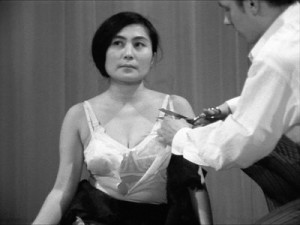 The end of this lecture moved to another aspect of conceptual art, “Happenings,” which were popular in the 1960’s. A group of people would be invited to a space, and each person would receive instruction to perform a certain act, such as, peel an orange, climb a ladder, sweep the floor, or shout a political slogan. All of that would take place simultaneously, and that would be the happening. The similarities to Sol Lewitt’s instructions for a painting are apparent, but in this case, not even the instructions count as the art object. The ephemeral event itself, the fact of the “happening” is the art object. To my mind, that is borderline nonsense, but in the context of what had gone before it, I will grant that it could be construed as art. An important conceptual artist in this genre was/is Yoko Ono.
The end of this lecture moved to another aspect of conceptual art, “Happenings,” which were popular in the 1960’s. A group of people would be invited to a space, and each person would receive instruction to perform a certain act, such as, peel an orange, climb a ladder, sweep the floor, or shout a political slogan. All of that would take place simultaneously, and that would be the happening. The similarities to Sol Lewitt’s instructions for a painting are apparent, but in this case, not even the instructions count as the art object. The ephemeral event itself, the fact of the “happening” is the art object. To my mind, that is borderline nonsense, but in the context of what had gone before it, I will grant that it could be construed as art. An important conceptual artist in this genre was/is Yoko Ono.
But again, if I call up five friends and invite them over to make spaghetti with me, does that count as an artistic happening? No. What counts as art is controlled by the thought leaders (thought-police?) who have the right combination of money, status, and media. I can’t declare my own art. That fact puts the lie to the idea of art as “a conversation” between artist and audience, focused on the artistic product. That model can’t work if “the audience” holds disproportionate power because, as Habermas noted, no such conversation can be in good faith. Is this conclusion cynical, or just realistic?
November 10, 2014
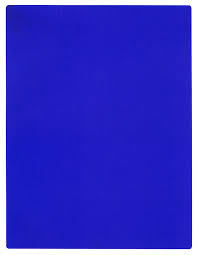 The previous lecture ended with consideration of artistic “happenings” in the 1960’s, which apparently evolved into the “Fluxus” movement, founded by a group of artists in New York City about that time. These people did not accept the authority of museums to determine what counts as art (a conclusion I reached on my own at the end of the previous lecture – why do I bother to strain my skull when the answers are forthcoming?).
The previous lecture ended with consideration of artistic “happenings” in the 1960’s, which apparently evolved into the “Fluxus” movement, founded by a group of artists in New York City about that time. These people did not accept the authority of museums to determine what counts as art (a conclusion I reached on my own at the end of the previous lecture – why do I bother to strain my skull when the answers are forthcoming?).
The Fluxus group wanted “happenings” and all forms of art to be available to the masses, so they would make up little puzzles and games and collages and sell them in classified advertisements to anyone who wanted to participate in modern art. No one wanted these gimmicks. Their idea was wrong. Somebody, if not the museums, then the art historians, have to be gatekeepers, the definers of art. Art is a collective social construction.
Nevertheless, the iconoclasm of the Fluxus movement had a certain wit that made it fun. They revered Duchamp.
 Postwar French art was not a direct response to American postmodernism, but French Nouveau Realism did incorporate images from American pop culture. The pieces shown in class – Giacometti, DuBuffet, Francis Bacon – seemed closer to abstract expressionism than postmodernism, to my eye. But apparently, the blend of postmodernism and Nouveau Realism evolved into Dada, an art movement that denied that art had any meaning at all. That, of course, is a self-refuting idea, like stating “I do not exist!” Still, everything that can be said, must be said.
Postwar French art was not a direct response to American postmodernism, but French Nouveau Realism did incorporate images from American pop culture. The pieces shown in class – Giacometti, DuBuffet, Francis Bacon – seemed closer to abstract expressionism than postmodernism, to my eye. But apparently, the blend of postmodernism and Nouveau Realism evolved into Dada, an art movement that denied that art had any meaning at all. That, of course, is a self-refuting idea, like stating “I do not exist!” Still, everything that can be said, must be said.
I was interested in Roland Barthes’ idea of cultural signifiers (in his “Mythologies”), suggesting that mass media produces a “false consciousness” that embraces the social status quo without question. Actually, I think that is the case for most people. It’s a very elaborate example of the naturalistic fallacy: What is, is taken to be “what ought to be.” It is a known error in thinking, but many people are susceptible to it anyway.
In art, Barthes’ ideas played out in production of junk sculptures, literally piles of junk that had no apparent meaning. In fact junk is defined as stuff that has been discarded, such as worn-out car tires, so whatever social and commercial meaning it once did have is gone. Artists would collect such junk and put it in frames and declare it art. Wink, wink, Duchamp. The artistic rationale was that looking at trash is an indirect way of looking at people. Some artists would frame a pile of their own detritus and call it a self- portrait. That’s a stretch, but I see the point.
 Pushing the idea to its logical limit was a wonderful piece displayed in the Iris Clert gallery, “Le Vide,” an absolutely empty vitrine, or display case. But it makes sense, because it simply illustrates that art is whatever is framed. Take a pile of junk, put a frame around it, you’ve got art. So why not dispense with the junk and just go with the frame. The frame’s the thing! (I wonder if artists ever smoke dope.) Yves Klein produced monochrome panels and called them art, which they were, because they were framed (first illustration above: Yves-Klein Blue).
Pushing the idea to its logical limit was a wonderful piece displayed in the Iris Clert gallery, “Le Vide,” an absolutely empty vitrine, or display case. But it makes sense, because it simply illustrates that art is whatever is framed. Take a pile of junk, put a frame around it, you’ve got art. So why not dispense with the junk and just go with the frame. The frame’s the thing! (I wonder if artists ever smoke dope.) Yves Klein produced monochrome panels and called them art, which they were, because they were framed (first illustration above: Yves-Klein Blue).
Inevitably, somebody had to think of it, and Piero Manzoni did. He collected his own shit, canned it, labelled it, and presented it as art, labelled “Merda d’Artista.” A tin was sold for €124,000 (about $155,000) at Sotheby’s on May 23, 2007. That makes a great story, and the professor  used it to emphasize that the artist defines what counts as art. It was the triumph of the Fluxus movement. And yet, I thought the professor might have emphasized the wrong point. It wasn’t about the shit at all. It was about the frame – in this case the can. A pile of shit by itself can never be art, no matter whose body it came out of. What turns it into art is the can, and its label.
used it to emphasize that the artist defines what counts as art. It was the triumph of the Fluxus movement. And yet, I thought the professor might have emphasized the wrong point. It wasn’t about the shit at all. It was about the frame – in this case the can. A pile of shit by itself can never be art, no matter whose body it came out of. What turns it into art is the can, and its label.
Despite the sometimes absurd productions of pomo artists, I believe they did manage to say something interesting and true about art, and even about the nature of consciousness in the context of creativity. Any conceptualization is an act of self-restraint, self-inhibition. To conceptualize something, you must stop what you’re doing, step out of the stream of consciousness for a moment, step back, and “frame” some aspect of experience. That’s what it means to conceptualize something and very few animals exhibit capacity for conceptualization – none so strongly as humans. We have the capacity for self-inhibition that artistic creativity requires. We are perhaps the only animal that can put a frame around something. We are the artists.
November 17
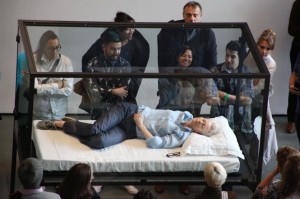 This lecture began with a survey of performance art, which involves some kind of interaction between the performer and the audience, and the performance need not be exuberant. An example is Tilda Swinton taking a nap in the MoMA. She’s in a glass box, and she sleeps, and people can look at her. What makes it artistically interesting is that it’s Tilda Swinton, famous actor. What you get to look at then, right up close, is celebrity itself. Why you would want to do that, I don’t know, but I do allow that celebrity is a social force of some kind and here it is on artistic display.
This lecture began with a survey of performance art, which involves some kind of interaction between the performer and the audience, and the performance need not be exuberant. An example is Tilda Swinton taking a nap in the MoMA. She’s in a glass box, and she sleeps, and people can look at her. What makes it artistically interesting is that it’s Tilda Swinton, famous actor. What you get to look at then, right up close, is celebrity itself. Why you would want to do that, I don’t know, but I do allow that celebrity is a social force of some kind and here it is on artistic display.
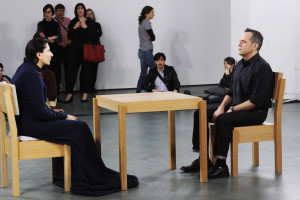 Marina Abramovic is not a celebrity, not outside the art world anyway, but her piece, “The Artist is Present” involved simply sitting silently across a small table from a museum-goer. You could sit there and stare at her for as long as you like. How is that art? The title of the performance is the key. What’s on artistic display is “presence” itself, the very presence of another human being. Anything that can be conceived, can be presented to an audience in an artistic way – as long as it is “approved” by the appropriate gatekeepers. That is, performance art, like any art, is only defined as art when it has the imprimatur of museum curators. Tilda Swinton sleeping at home tonight is not art.
Marina Abramovic is not a celebrity, not outside the art world anyway, but her piece, “The Artist is Present” involved simply sitting silently across a small table from a museum-goer. You could sit there and stare at her for as long as you like. How is that art? The title of the performance is the key. What’s on artistic display is “presence” itself, the very presence of another human being. Anything that can be conceived, can be presented to an audience in an artistic way – as long as it is “approved” by the appropriate gatekeepers. That is, performance art, like any art, is only defined as art when it has the imprimatur of museum curators. Tilda Swinton sleeping at home tonight is not art.
The question arose in class, a question I had already asked myself, is there – has there been – progress in art? Did we start out with representations of landscapes and people, and “move on” to impressionism, then abstraction, then kinetic art, then conceptual art, and so on, at each step abstracting artistic objects and their referents into ever-more ethereal insubstantiality? Professor Ivey said no. There is no “arrow of art history.” There is an informal dialectic, a back-and-forth dialog that sometimes leads to a synthesis, but – and this is the point – there is no telos. The evolution of modern art is not heading “towards” anything. There is no final goal. There is no directionality. All we have is dialog.
 Except, maybe there is a kind of negative telos. As a species, we are destroying the planet rather rapidly, and there is some realistic fear that future generations will not be able to survive the changes we wreak. So in that sense, all artistic endeavor (as well as all science, literature, and other human activity) must be in a context of avoiding total self-annihilation. If we collectively commit suicide, there is no audience left to enjoy the irony of that performance, so it cannot be art. Thus, there is, after all, a universal value even for the postmodernists: we desire, as a species, to continue living.
Except, maybe there is a kind of negative telos. As a species, we are destroying the planet rather rapidly, and there is some realistic fear that future generations will not be able to survive the changes we wreak. So in that sense, all artistic endeavor (as well as all science, literature, and other human activity) must be in a context of avoiding total self-annihilation. If we collectively commit suicide, there is no audience left to enjoy the irony of that performance, so it cannot be art. Thus, there is, after all, a universal value even for the postmodernists: we desire, as a species, to continue living.
 Lady Gaga was presented as a performance artist, not merely because she sings (rather well, I’d say), but because she creates an interactive spectacle that could be construed as an artistic expression. The trouble with that example is that she does not have the approval of the artistic gatekeepers. It raises questions. Was the publicity stunt or event created by Pussy Riot, considered art? They danced and screamed (sang?) inside a Russian Orthodox church and were predictably arrested and imprisoned. A political act, yes, but was it performance art? The professor says yes, because they define themselves as artists (musicians).
Lady Gaga was presented as a performance artist, not merely because she sings (rather well, I’d say), but because she creates an interactive spectacle that could be construed as an artistic expression. The trouble with that example is that she does not have the approval of the artistic gatekeepers. It raises questions. Was the publicity stunt or event created by Pussy Riot, considered art? They danced and screamed (sang?) inside a Russian Orthodox church and were predictably arrested and imprisoned. A political act, yes, but was it performance art? The professor says yes, because they define themselves as artists (musicians).
That answer didn’t satisfy me, until I realized that I had overlooked one of the most important gatekeepers, and thus definers, of what counts as art: the media. If the mass media displays a performance, then it counts as art. The Pussy Riot performance was taped and that tape was seen worldwide. That gives it the stamp of legitimate art. As does Lady Gaga’s public performances. So any artist still must get the nod from an official guardian of art, in order for a work to qualify, but in addition to the traditional guardians – curators, collectors, critics, and academics – we must now consider the mass media.
It’s not a perfectly clear answer. If I take a picture of something, that puts a frame around it, but it does not automatically make it art. If Diane Arbus or Anne Liebowitz takes the same picture, then it is art, I think. Although perhaps not if it’s never shown. That’s the key – the work would have to be shown, in a context that has the approval of the cultural arbiters. It’s not about the photograph, not about the subject of the picture, not even about the frame. Art is defined by a collection of arbiters that the culture tacitly accepts.
 We looked also at video art. Christian Marclay’s wonderful video, Telephones (1995) [On YouTube: www.youtube.com/watch?v=yH5HTPjPvyE], Dara Birnbaum’s Technology Transformation (http://www.dailymotion.com/video/x4y5e5_dara-birnbaum-technology-transforma_shortfilms), and the marvelous Semiotics of the Kitchen, by Martha Rossler (www.youtube.com/watch?v=3zSA9Rm2PZA). Why are these videos “artistic?” I’m not sure I’m able to say, and the professor did not address that question. At this point, all I can say about labeling video as art is the Clement Greenbergian expression, “I know it when I see it.”
We looked also at video art. Christian Marclay’s wonderful video, Telephones (1995) [On YouTube: www.youtube.com/watch?v=yH5HTPjPvyE], Dara Birnbaum’s Technology Transformation (http://www.dailymotion.com/video/x4y5e5_dara-birnbaum-technology-transforma_shortfilms), and the marvelous Semiotics of the Kitchen, by Martha Rossler (www.youtube.com/watch?v=3zSA9Rm2PZA). Why are these videos “artistic?” I’m not sure I’m able to say, and the professor did not address that question. At this point, all I can say about labeling video as art is the Clement Greenbergian expression, “I know it when I see it.”
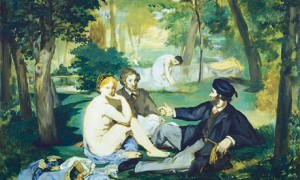 The professor suggested that the artistic “product” on display in video art is something like telepresence. You, the audience are both here (in the gallery), and there (in the video’s world), a sensation that grew, he said, out of the development of wireless telegraphy in the 1840’s, which allowed you to “be” in two places at once. Telepresence since then has marked a profound transformation in how art is experienced. But I am not so sure about that. Wasn’t Manet’s 1862 painting, Le Déjeuner sur l’herbe a clear exercise in telepresence? Wasn’t that the whole point of it? I feel there is more to be said on this topic.
The professor suggested that the artistic “product” on display in video art is something like telepresence. You, the audience are both here (in the gallery), and there (in the video’s world), a sensation that grew, he said, out of the development of wireless telegraphy in the 1840’s, which allowed you to “be” in two places at once. Telepresence since then has marked a profound transformation in how art is experienced. But I am not so sure about that. Wasn’t Manet’s 1862 painting, Le Déjeuner sur l’herbe a clear exercise in telepresence? Wasn’t that the whole point of it? I feel there is more to be said on this topic.
December 1, 2014
 Feminist art – is there such a thing? Perhaps there once was, in the 1960’s. But why would a 21st century professor be furthering the myth that women are some kind of separate species with their own art forms? I was appalled. Yet, an obvious answer is that he is a historian, so I allowed that he was justified in reporting on what happened a half-century ago when many women artists reacted against their systematic exclusion from the art world. But as the lecture and the examples moved toward modern times, I found the professor’s insistence on treating art produced by women as a separate topic, increasingly grating.
Feminist art – is there such a thing? Perhaps there once was, in the 1960’s. But why would a 21st century professor be furthering the myth that women are some kind of separate species with their own art forms? I was appalled. Yet, an obvious answer is that he is a historian, so I allowed that he was justified in reporting on what happened a half-century ago when many women artists reacted against their systematic exclusion from the art world. But as the lecture and the examples moved toward modern times, I found the professor’s insistence on treating art produced by women as a separate topic, increasingly grating.
The 1960s and 1970s produced a surge of feminist changes, including the formation of the National Organization for Women, the almost-passage of the Equal Rights Amendment, the passage of Roe v. Wade, publication of Betty Friedan’s “The Feminine Mystique,” among many other social phenomena. According to the professor, the main goals of feminist art were,
1. to get women artists included in the canon of “great artists,”
2. to overcome stereotypes in how women are represented in art,
3. to affirm a history (“herstory”) of women’s achievements in art.
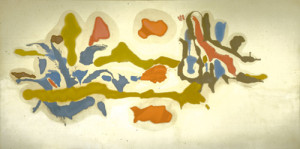 How could these noble goals be accomplished? That was a difficult question for the artists themselves. Should women artists produce the same kind of work men artists were making? Some took that route and became abstract expressionists, for example (Helen Frankenthaler comes to mind – although she was systematically excluded from the professor’s earlier lectures covering the ab-ex artists, and she was not mentioned in this lecture, either). Or, did women artists have a special “feminine” point of view, a unique sensibility that they should promulgate as an alternative to men’s art?
How could these noble goals be accomplished? That was a difficult question for the artists themselves. Should women artists produce the same kind of work men artists were making? Some took that route and became abstract expressionists, for example (Helen Frankenthaler comes to mind – although she was systematically excluded from the professor’s earlier lectures covering the ab-ex artists, and she was not mentioned in this lecture, either). Or, did women artists have a special “feminine” point of view, a unique sensibility that they should promulgate as an alternative to men’s art?
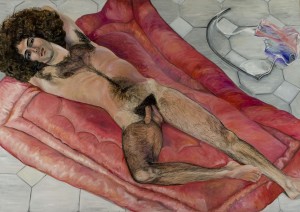 Or, should women artists react as a kind of polar opposite to men’s art, as some did: Sylvia Sleigh comes to mind. She often depicted male nudes in a way that paralleled and mocked traditional female nude images that populate art museums. Oddly, I thought that approach didn’t work, although that could be just because I’m a hetero male. The male nudes have a certain painterly aesthetic, but as representations, they don’t carry much force, either erotic or aesthetic or in terms of power-relationship. The symmetry that Sleigh was aiming at doesn’t exist, I think. Even today, heterosexual men still “own” the visual
Or, should women artists react as a kind of polar opposite to men’s art, as some did: Sylvia Sleigh comes to mind. She often depicted male nudes in a way that paralleled and mocked traditional female nude images that populate art museums. Oddly, I thought that approach didn’t work, although that could be just because I’m a hetero male. The male nudes have a certain painterly aesthetic, but as representations, they don’t carry much force, either erotic or aesthetic or in terms of power-relationship. The symmetry that Sleigh was aiming at doesn’t exist, I think. Even today, heterosexual men still “own” the visual  representation of women, and use it to project their own sexual anxieties and eroticism. Do women make converse projections onto representations of nude males? I doubt it, if for no other reason than that they have historically lacked opportunity to do so, and this gets at the core problem of “feminist art,” in my way of thinking: Men are the gatekeepers. Men are, for the most part, the curators, collectors, historians, reviewers, and critics. That has changed some in recent years, but only a little, and only recently.
representation of women, and use it to project their own sexual anxieties and eroticism. Do women make converse projections onto representations of nude males? I doubt it, if for no other reason than that they have historically lacked opportunity to do so, and this gets at the core problem of “feminist art,” in my way of thinking: Men are the gatekeepers. Men are, for the most part, the curators, collectors, historians, reviewers, and critics. That has changed some in recent years, but only a little, and only recently.
Professor Ivey did not consider the possibility that the problem of women’s exclusion from mainstream art was not about biology, and not about a special feminine point of view, but, purely and simply, a problem of capitalism and control of social institutions. As long as women were and are excluded from the gatekeeper class, there was little chance they would ever be acknowledged as great artists – that’s the obvious problem of feminist art. But the professor spent the lecture talking about women’s unique biology, social experience, and mentality, as if those were the main issues. This was frustrating to me, but in fairness, I admit that most women artists at the time also struggled with the question of what constituted feminist art. Even today, people in America are naïve about who controls the money and the social power, and that those are the forces that constitute the culture. I nevertheless feel that the professor had some social responsibility to broach that topic and not ignore it.
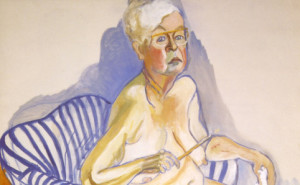 The first “wave” of feminist art did tend to focus on biology, with reactive role-reversal concerning the imagery of the human body. Some, like Alice Neel, emphasized unsentimental, un-erotic, de-mystified images of the female body, trying to counter the stereotypes. All these efforts were doomed, in my opinion, because the problem never was about biology. It was always about money and social power.
The first “wave” of feminist art did tend to focus on biology, with reactive role-reversal concerning the imagery of the human body. Some, like Alice Neel, emphasized unsentimental, un-erotic, de-mystified images of the female body, trying to counter the stereotypes. All these efforts were doomed, in my opinion, because the problem never was about biology. It was always about money and social power.
 Later artists started to recognize that men controlled the visual representation and even the definition of women, and tried to regain control. An example is Lisa Ticknor’s “The Body Politic,” based on the idea (as one female critic said) that “Living in a female body is different from looking at it, as a man.” Unfortunately, and inevitably, the advertising and movie industries, controlled by men, immediately co-opted the new feminist art and sold it back to society as the image of the pseudo-powerful (yet harmless) woman, nominally “liberated” but actually still under the masculine thumb.
Later artists started to recognize that men controlled the visual representation and even the definition of women, and tried to regain control. An example is Lisa Ticknor’s “The Body Politic,” based on the idea (as one female critic said) that “Living in a female body is different from looking at it, as a man.” Unfortunately, and inevitably, the advertising and movie industries, controlled by men, immediately co-opted the new feminist art and sold it back to society as the image of the pseudo-powerful (yet harmless) woman, nominally “liberated” but actually still under the masculine thumb.
A big move forward was Judy Chicago’s establishment of Womanhouse in 1972, an art studio and gallery by and for women. This was a small but important step because it was a move to address the real source of the feminist problem, the exclusively male gatekeeper class.
Other efforts involve the rehabilitation of so-called “women’s arts” such as quilting, needlepoint, and ceramics, although “decorative arts” remained a pejorative term in the art world.
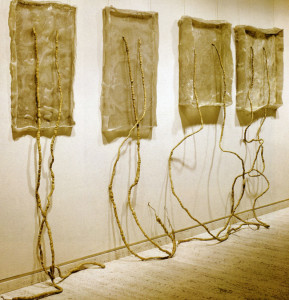 The professor rambled on for a good half hour on the thesis that “male art” tended to rectilinear forms (e.g., Saul Lewitt, Carl Andre) while “female art” tended to more organic, biomorphic shapes. This struck me as a naïve, glib, unsupported pile of steaming horse manure (feminine shape?), but nothing could dissuade him from it. As the lecture and examples moved closer to the modern period, the professor continued to talk about “feminine art” in these ridiculous terms and in others equally absurd (such as “erotic spaces” and the patently counterfactual assertion that “women, at least, control reproduction”). He seemed incapable of questioning if there is such a thing as “feminine art” worthy of discussion. It was a historical moment, perhaps, but Ivey talked as if he, himself were still stuck in a 1970s mentality.
The professor rambled on for a good half hour on the thesis that “male art” tended to rectilinear forms (e.g., Saul Lewitt, Carl Andre) while “female art” tended to more organic, biomorphic shapes. This struck me as a naïve, glib, unsupported pile of steaming horse manure (feminine shape?), but nothing could dissuade him from it. As the lecture and examples moved closer to the modern period, the professor continued to talk about “feminine art” in these ridiculous terms and in others equally absurd (such as “erotic spaces” and the patently counterfactual assertion that “women, at least, control reproduction”). He seemed incapable of questioning if there is such a thing as “feminine art” worthy of discussion. It was a historical moment, perhaps, but Ivey talked as if he, himself were still stuck in a 1970s mentality.
 Despite my rising frustration at the lecture, I did enjoy his presentation of the work of Cindy Sherman, a photographer I have admired, and who is still working, I believe. She took pictures of herself in various costumes, settings, and “presentations,” but they were not self-portraits, she insisted. Rather, she was demonstrating how woman can assume many different forms, like chimera. These were photos of different
Despite my rising frustration at the lecture, I did enjoy his presentation of the work of Cindy Sherman, a photographer I have admired, and who is still working, I believe. She took pictures of herself in various costumes, settings, and “presentations,” but they were not self-portraits, she insisted. Rather, she was demonstrating how woman can assume many different forms, like chimera. These were photos of different 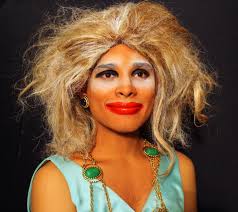 subjectivities, not of one objective woman. And, I think, a poke in the eye to men, saying, “you think you control how we are represented, but actually, we control how we appear to you, so joke on you, buddy.” It’s a wonderful, multi-layered narrative.
subjectivities, not of one objective woman. And, I think, a poke in the eye to men, saying, “you think you control how we are represented, but actually, we control how we appear to you, so joke on you, buddy.” It’s a wonderful, multi-layered narrative.
The theme of women (and race) as social construction was taken up by other artists, including Betye Saar, in her wonderful 1972, “The Liberation of Aunt Jemima,” and Barbara Kruger, whose mix of language and photography I think is brilliant.
 I’m a huge fan of philosopher Judith Butler and for over a decade I have been convinced that gender is entirely a social construction, so I was upset that Professor Ivey didn’t seem to embrace that view with as much enthusiasm as I have for it. Therefore, his lecture was both stimulating and infuriating. I was so upset with his superficial and outdated views on “feminist art” that I couldn’t stay for the Q & A session at the end. At the same time, I have to hand it to him because he got to me, made me think, made me mad – and isn’t that his job as a professor?
I’m a huge fan of philosopher Judith Butler and for over a decade I have been convinced that gender is entirely a social construction, so I was upset that Professor Ivey didn’t seem to embrace that view with as much enthusiasm as I have for it. Therefore, his lecture was both stimulating and infuriating. I was so upset with his superficial and outdated views on “feminist art” that I couldn’t stay for the Q & A session at the end. At the same time, I have to hand it to him because he got to me, made me think, made me mad – and isn’t that his job as a professor?
December 8, 2014
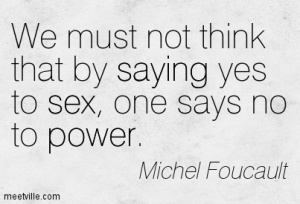 This lecture began with a survey of some “theories” of postmodern art, really just conceptualizations or angles for interpretation, collectively called, “Theory.”
This lecture began with a survey of some “theories” of postmodern art, really just conceptualizations or angles for interpretation, collectively called, “Theory.”
One approach to interpretation is the “Repressive Hypothesis” championed by Michel Foucault in the 1980’s. This idea says that when you repress an idea in a culture, like female sexuality, an idea that was supposedly repressed in the Victorian era, then you actually give it more strength and power. Sexuality is created by dialog, and if dialog is not permitted, the topic has more force in the society. Thus, the Victorians were not sexually repressed – they just didn’t talk about sex in public, but sexuality, especially female sexuality, was very present in the society.
Today, that’s not the case. Sexual talk and imagery are omnipresent. Does it mean that sexuality has lost its power in modern society? Who knows? It’s a flimsy idea to start with and the professor offered no follow-up on it.
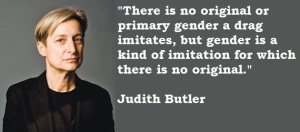 Instead, he went on to read a list of highlights from Judith Butler’s work, “Gender Trouble.” She is a major philosopher of gender and queer studies. Her main point, of course, is that gender is entirely constructed in society. By the time you are conscious enough and self-aware enough to discuss gender, it’s too late – your ideas and attitudes are baked into your skull through the process of socialization. That’s why most people believe that gender identity is given rather than constructed.
Instead, he went on to read a list of highlights from Judith Butler’s work, “Gender Trouble.” She is a major philosopher of gender and queer studies. Her main point, of course, is that gender is entirely constructed in society. By the time you are conscious enough and self-aware enough to discuss gender, it’s too late – your ideas and attitudes are baked into your skull through the process of socialization. That’s why most people believe that gender identity is given rather than constructed.
Professor Ivey just read these sound bytes off a screen, offering no commentary on the “theory.” I got the sense that if he actually were engaged by it, he wouldn’t have made such a botch of his presentation the previous week on so-called “feminist art.”
Another “theory” is that of Roland Barthes, in the 1960’s, concerning “The Death of the Author,” an idea already broached in this course. The idea is that the intentionality of the author in literature, and the artist in art, has nothing to do with the meaning of the artistic product. Instead, meaning is found in interaction between the work and the viewer. The author is, essentially “dead.”
 This is another of those flimsy ideas inexplicably taken seriously by critics and historians. Traditionally, since the time of Aristotle at least, many people conceptualize the process of art as a triangle, with the three corners representing 1. The author’s intentionality, 2. The work or art, and 3. The audience’s interpretation (for Aristotle, the three corners are Ethos, the credibility or authority of the speaker/writer; Logos, use of reason and evidence in making an argument; and Pathos, the emotional appeal to the audience.) Knocking out one of these corners is arbitrary and unjustified, although it transfers power to the gatekeeper class, which is perhaps why they like to imagine that the author is dead.
This is another of those flimsy ideas inexplicably taken seriously by critics and historians. Traditionally, since the time of Aristotle at least, many people conceptualize the process of art as a triangle, with the three corners representing 1. The author’s intentionality, 2. The work or art, and 3. The audience’s interpretation (for Aristotle, the three corners are Ethos, the credibility or authority of the speaker/writer; Logos, use of reason and evidence in making an argument; and Pathos, the emotional appeal to the audience.) Knocking out one of these corners is arbitrary and unjustified, although it transfers power to the gatekeeper class, which is perhaps why they like to imagine that the author is dead.
A more generous “theory” of why Barthes, or anybody else, would be tempted to dispose of the author’s/artist’s intentionality in consideration of artistic meaning, would be that in modern times, many people are confused by asynchronous communication – the kind that does not require the speaker and the listener to be contemporaneous. Email is asynchronous, which is its great virtue. Unlike a phone call, the messages we exchange can be sent and received by email at different (asynchronous) times.
Works of art, such as novels and paintings, are asynchronous. The author does not have to be contemporaneous with the audience in order to convey his/her creative intentionality. It is a naïve and profound mistake, yet a common one, to believe that since the author is not present to the audience, that the author doesn’t matter, or is “dead.”
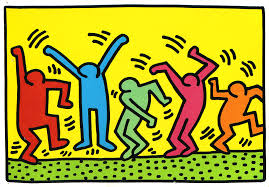 What an author says explicitly about his/her intentions in creating the work may be only marginally relevant. Humans don’t know why they do what they do half the time anyway. Still, the creative impulse (and the craft of realizing it) are human phenomena, whether or not a particular author was able to articulate his/her intentions in a way that satisfies the current audience. That is the only reason we are interested in the work in the first place – because it is a human self-expression. Failure to understand the intersubjective context of art appreciation is a failure of “theory.”
What an author says explicitly about his/her intentions in creating the work may be only marginally relevant. Humans don’t know why they do what they do half the time anyway. Still, the creative impulse (and the craft of realizing it) are human phenomena, whether or not a particular author was able to articulate his/her intentions in a way that satisfies the current audience. That is the only reason we are interested in the work in the first place – because it is a human self-expression. Failure to understand the intersubjective context of art appreciation is a failure of “theory.”
Having perfunctorily dispensed with “theory,” without much comment, and no discussion, the professor moved on to consideration of graffiti as art. He considered subway art of the 1980’s and the art world’s attempts to “aestheticize” street art (have the gatekeepers confer legitimacy). Some of it moved to galleries, and to arranged tagging parties. Prominent examples of “legitimate” street art were from Keith Haring and Basquiat in the 1970’s.
 When street art was legitimized, it lost its street cred and came to look a lot like recycled pop art (e.g., Lichtenstein). Oddly, the professor did not mention the Chicano mural movement, which did not undergo the same fate. (This course is 99.9% white and 95% male, for some reason.)
When street art was legitimized, it lost its street cred and came to look a lot like recycled pop art (e.g., Lichtenstein). Oddly, the professor did not mention the Chicano mural movement, which did not undergo the same fate. (This course is 99.9% white and 95% male, for some reason.)
A major factor in postmodern art is “appropriation” (aka, plagiarism). Artist have always “borrowed” from other artists, but pomo artists take it as a matter of principle that a copy of a work is another standalone work of art, because they reject the natural validity of “the original.” If you take a photo of a landscape, what is the “original?” The landscape itself? And typically, a photographer will take dozens of shots, and select only one to print. Why does that selection bestow “originality” on the one shot that is printed and shown?
So pomo artist were/are fond of taking photographs of art works, or even of other photographs and displaying them as valid works of art in their own right. In some cases the “copies” seem to become more original than the source object (The “Marlboro” western art is an example).
This segued into a discussion of photography of art. Sherrie Levine took photos of other photos that appeared in books, to provoke the question of the validity of “the original.” Surely a reproduction of a photograph printed in a book cannot be considered an “original” so what’s wrong with re-photographing that published picture and calling it art? (Other than consideration of intellectual property rights).
 Jeff Koons was cited as an example of problematic “appropriation.” One his sculptures was a close copy of a well-known photograph, and the photographer sued. Koons lost. The settlement was that the photographer would accept the sculpture in question as a gift. (Nice settlement! Anything by Koons is worth millions today.)
Jeff Koons was cited as an example of problematic “appropriation.” One his sculptures was a close copy of a well-known photograph, and the photographer sued. Koons lost. The settlement was that the photographer would accept the sculpture in question as a gift. (Nice settlement! Anything by Koons is worth millions today.)
By the 1990’s photography had become “painterly,” in the sense that it self-consciously took up some of the formalisms of painting. That was important in the move to have photography reconsidered as “fine art” rather than just instrumentation.
Another movement (e.g., Richard Avedon) was to photograph ordinary people, especially the homeless and mentally ill, and others at the margins of society. This was considered portraiture.
 A category of photography that has always perplexed me is wedding pictures. What are those about? Everybody’s dressed up in weird costumes and engaging in very non-normal behavior and showing a lot of teeth – it’s completely contrived. Those aren’t real people, and that is not their lives. They are hiding, not showing themselves. What’s photographed is completely unnatural, and I would say, bizarre. Why would you want pictures to remember an event that was utterly contrived?
A category of photography that has always perplexed me is wedding pictures. What are those about? Everybody’s dressed up in weird costumes and engaging in very non-normal behavior and showing a lot of teeth – it’s completely contrived. Those aren’t real people, and that is not their lives. They are hiding, not showing themselves. What’s photographed is completely unnatural, and I would say, bizarre. Why would you want pictures to remember an event that was utterly contrived?
Maybe wedding photography is supposed to be the opposite of Avedon’s homeless people? I am stumped, and there was no opportunity in class for discussion. I should interview a wedding photographer.
I enjoyed a presentation of Jeff Wall’s work, a photographer I have long admired. He is able to capture the essence of squalor. That’s how I’d characterize his talent. But I had not realized that his scenes were staged and manufactured, not “found.” That diminishes my respect for his “eye” but only by a little.
Photographers who manufacture a scene to be photographed (wedding photographers?) are perhaps making the point that photography is not truth. Many people seem to still believe that if they saw a picture of it, it must be real. That’s incredibly naïve, but it’s a historical holdover. I wonder if in the 19th century people felt that way about naturalistic painting (e.g., Manet’s Lunch on the Grass).
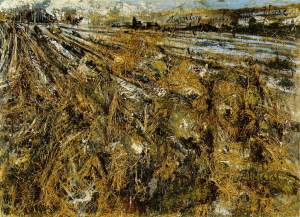 The final section of the lecture concerned contemporary German art, starting from the question, how can anything aesthetic be said after the holocaust? Much of the art shown had a holocausty feel, such as Kiefer’s 1981 “Your Golden Hair…” and his sculptures in lead – airplanes and birds that cannot fly, books whose pages cannot be turned.
The final section of the lecture concerned contemporary German art, starting from the question, how can anything aesthetic be said after the holocaust? Much of the art shown had a holocausty feel, such as Kiefer’s 1981 “Your Golden Hair…” and his sculptures in lead – airplanes and birds that cannot fly, books whose pages cannot be turned.
We looked at some Gerhard Richter, in which paintings were made to look like photographs, an ironic reversal of the trend in photography.
The professor’s lecture I thought focused too much on the influence of the holocaust and not enough on the art itself. For a pomo art course, where the author is supposedly dead, we should have looked at more pictures and talked less about Nazis.
But it’s all good. This class is stimulating even when it’s off-base.
Dec 10th, 2014
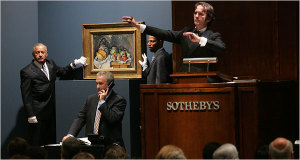 This last lecture in the series on Postmodern Art covered “Activist Art,” aka politically motivated art, protest art. There were several categories of activism surveyed.
This last lecture in the series on Postmodern Art covered “Activist Art,” aka politically motivated art, protest art. There were several categories of activism surveyed.
Included were art works that protested against the role of big money in the art world. Prices for art work have gone sky-high even while funding for the arts has plummeted. The elite, monied class collects art not for aesthetic, historical, or philosophical value, but merely as an investment vehicle. This practice seems to grate mightily on artists who resent having success controlled by the wealthy.
It isn’t a compelling criticism to me, however. There are many cooperative art galleries that are free of big money interests. None of these were mentioned in the lecture, perhaps because the art found in them does not have the imprimatur of the “Official Gatekeepers” of what counts as first-tier art, and therefore will never be auctioned at Sotheby’s for millions. It’s still good art, though. Anybody can buy high-quality art at cooperatives, or even sometimes at street fairs. That’s where I get my art. It will never be “big-money” art, but I enjoy it, I pay the artists what I can afford, and they earn what they can.
There is an unacknowledged dichotomy between the two categories of art – “official” art that draws the big bucks, and “ordinary art” that doesn’t, but which is just as beautiful or challenging as any. The difference is unacknowledged in courses like this, perhaps because the gatekeepers (like this professor of art history) do not want to draw attention to their pernicious role in the intersection of capitalism and the art world.
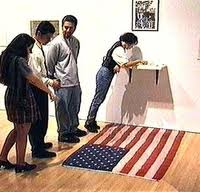 Political protest art has always been plentiful, and some examples were shown. A piece embodying the tension is Dread Scott’s, “What is the proper way to display the flag.” In order to write your thoughts in the comment book, you have to step on a U.S. flag placed on the floor in front of the book.
Political protest art has always been plentiful, and some examples were shown. A piece embodying the tension is Dread Scott’s, “What is the proper way to display the flag.” In order to write your thoughts in the comment book, you have to step on a U.S. flag placed on the floor in front of the book.
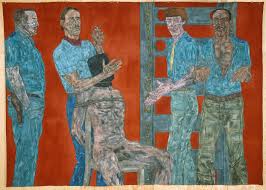 Leon Golub’s “Interrogation,” from 1981 is as relevant today as it was then.
Leon Golub’s “Interrogation,” from 1981 is as relevant today as it was then.
The lecture noted in some detail that Hitler, and many of his closest associates, were aspiring (failed) artists and that the Nazi movement in general was obsessed by art. However, being utterly ignorant, they defined art as sentimental idealism and banned all else as “degenerate.”
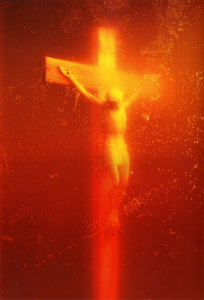 A comparison was drawn to art censorship in America, and in other countries, something that seems to occur whenever ignorant politicians decide they must protect the public from indecency and “bad” art. Examples cited were from Robert Mapplethorpe’s photography and Andres Serrano’s “Piss Christ,” (1987) a crucifix displayed in a tank of urine. The professor noted that the piece is quite attractive, reminiscent of Spanish renaissance art, and if the crucifix had been suspended in a tank of beer, it would’ve been on billboards. But because it was urine (which is sterile, and which represents the purification of the blood), the piece was considered indecent. Seven of nine copies of it have been vandalized.
A comparison was drawn to art censorship in America, and in other countries, something that seems to occur whenever ignorant politicians decide they must protect the public from indecency and “bad” art. Examples cited were from Robert Mapplethorpe’s photography and Andres Serrano’s “Piss Christ,” (1987) a crucifix displayed in a tank of urine. The professor noted that the piece is quite attractive, reminiscent of Spanish renaissance art, and if the crucifix had been suspended in a tank of beer, it would’ve been on billboards. But because it was urine (which is sterile, and which represents the purification of the blood), the piece was considered indecent. Seven of nine copies of it have been vandalized.
A serious problem with protest art is that as soon as it is placed inside a museum, it is already aestheticized, robbing it of its intensity. The museum erases the protest as soon as they give a piece the thumbs up. If it’s in a museum, it’s art, not protest.
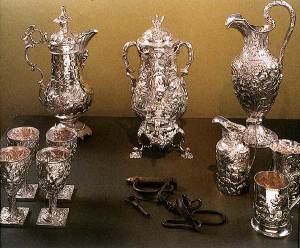 A simple but powerful form of protest art uses the technique of juxtaposition. An example is Fred Wilson’s piece, displaying a beautiful handmade silver tea service from the 1800’s, along with a set of slave shackles.
A simple but powerful form of protest art uses the technique of juxtaposition. An example is Fred Wilson’s piece, displaying a beautiful handmade silver tea service from the 1800’s, along with a set of slave shackles.
AIDs activism in the 1980s produced a lot of art, especially poster art, protesting the government’s inaction in the face of the epidemic, and the public’s indifference.
A few examples of so-called “feminist art” were dredged up again, for example, protests concerning women’s right to control their own reproduction.
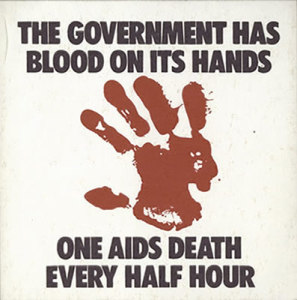 So what is the takeaway message behind all these examples of protest, activist art? One is that culture is not separate from politics. Politicians recognize the power of art in shaping public ideas and try to manage that. The controversy over the Vietnam War memorial in Washington, D.C. was an example. There is no set of universal values, and people who could not appreciate abstraction insisted on (and got) another, second, memorial, a super-realist bronze representation of some soldiers. Are the people who can’t understand abstraction deficient in some way? I think so, but in America, that doesn’t matter. If you need to see a realistic representation of a soldier in order to understand that many soldiers fought and died, then you have a right to see that.
So what is the takeaway message behind all these examples of protest, activist art? One is that culture is not separate from politics. Politicians recognize the power of art in shaping public ideas and try to manage that. The controversy over the Vietnam War memorial in Washington, D.C. was an example. There is no set of universal values, and people who could not appreciate abstraction insisted on (and got) another, second, memorial, a super-realist bronze representation of some soldiers. Are the people who can’t understand abstraction deficient in some way? I think so, but in America, that doesn’t matter. If you need to see a realistic representation of a soldier in order to understand that many soldiers fought and died, then you have a right to see that.
A less obvious lesson is that museums and galleries construct “art history,” by curation and gatekeeping. Art museums were compared to department stores, where you can (intellectually) “shop” for different categories and “movements” of cultural history. Even natural history museums construct the past, with dioramas that demonstrate, for example, “cave-man” families in naturalistic settings, suggesting that monogamy and the nuclear family are “given” in history. No evidence supports such a presumption.
 This gets exactly at my objection to this lecture. While it was ostensibly a survey of the exercise of money and power on art, it systematically omitted consideration of the role of the historians, curators, collectors, and media coverage that defines what counts as “real” art, excluding most of it. Discussion of how art expresses power relations in the society, skips right over the underlying question of what counts as art in the first place. That question was displaced, by design or self-blindness.
This gets exactly at my objection to this lecture. While it was ostensibly a survey of the exercise of money and power on art, it systematically omitted consideration of the role of the historians, curators, collectors, and media coverage that defines what counts as “real” art, excluding most of it. Discussion of how art expresses power relations in the society, skips right over the underlying question of what counts as art in the first place. That question was displaced, by design or self-blindness.
This course has been highly stimulating, informative, and provocative. At the same time it has been infuriating for offering examples that are 99.9% white, 95% male, and 98% U.S.-centric. Perhaps those limitations are practical ones imposed by the course structure and length, but if so, the constraints should have been stated at the beginning.
There is no perfect college course. However, this one was fun and interesting, and consistently pushed my buttons, and my buttons are hard to push, so I have to give it an A.


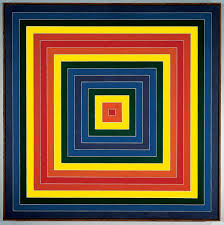
I really enjoyed reading your comments about Prof. Ivey’s course. I came across them by accident – I am going to a lecture by Prof. Ivey this evening, and decided to quickly “google ” him, and found your blog. I am not an artist – but a Ph.D. (Lit), but very interested in the arts.
Thank you!